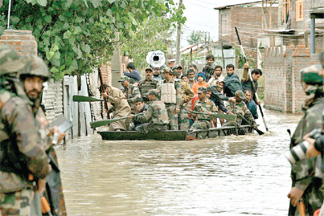
It happens once in 100 years they say and when it happens there is not much you can do about it. However, in modern times disaster relief can be much faster and more effective if planning and preparation is done well in advance and rehearsals executed. Uttarkhand should give have given all hill bound states the warning that it can happen anywhere.
|
30,000? : troops developed by Army—21,000 in Kashmir and 9,000 in Jammu region for rescue and relief operation.? 19?: relief camps have been set up by the armed forces in Srinagar and Jammu region.? |
The time is not ripe for blame game for the moment. The immediate need is to provide relief for 6 lakh people. Even when they are rescued from flooded areas there is isn”t enough space to house them in higher areas. An organised movement of displaced people to other areas of Kashmir will have to be affected as soon as possible for which transport, tents and cooking utensils besides supplies and sanitation means will have to be created in each such camp with communication facilities. This has to be done in a hurry as the winter is approaching and many displaced people are likely to afford the reconstruction of their homes in the given time.
The gravity of the situation has to be realised in the area of drainage of the flood waters which will not find openings away from the existing wet land. The water is likely to remain stagnant for some time. This will have two effects – the health hazard for which the health authorities at national level will have to better be prepared in the next few days. Secondly, the time that the water remains stagnant will dictate how early the reconstruction efforts can begin. Some priority areas such as government buildings will need to have water pumped out with heavy duty pumps as quickly as possible.
There is a shortage of boats in the Valley; if more can be flown in it will help. Important will also be setting up communication facilities to allow contact between traumatised people who are stuck and their relatives. This has to be restored by any means. It will be helpful in areas that are totally cut off and were no government official is available. Those not affected in Bandipur, Kupwara and Baramula districts will need to be moved to Old Airfield to commence the civil government”s relief effort.
Command and control is an essential element in such situations; a clear cut chain of authority needs to be established. There is much debate about imposing Governor”s rule immediately. My humble submission is to place the Army in charge for next 15 days, empower the Army”s senior hierarchy to take actions on their own and slowly re-establish civil governance in most areas that are still with the Army. Decisions on Governor”s rule can be taken subsequently after initial relief operations get over.
Lastly, this is a National tragedy and there is tremendous concern everywhere. Delhi and the metropolitan cities should therefore become the nodal centres from where relief should flow with designated authorities made responsible for receiving and distributing aid. NGOs, especially those related to the health sector must be moved on priority to the affected areas because health related equipment and personnel will be in demand and their shortage can aggravate health hazards that may arise as a result of stagnant water in the Valley; even the Army will face problems as far as health emergencies are concerned.
Lastly, the army personnel will need to be continuously motivated to keep doing their work for which they are arleady being praised from people across the country.
-Lt Gen (Retd) SA Hasnain? (The writer is a retired Army officer and commanded an Army corps in J&k.)?














Comments